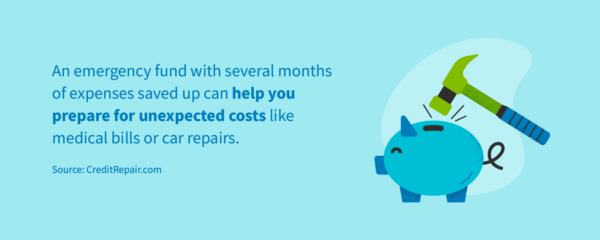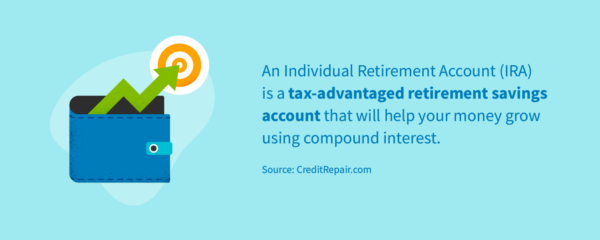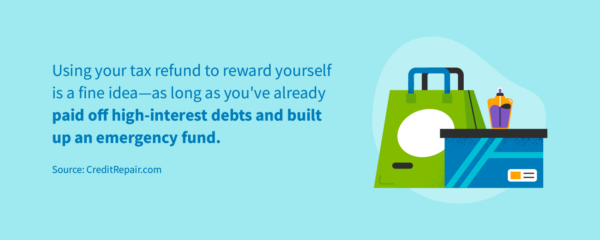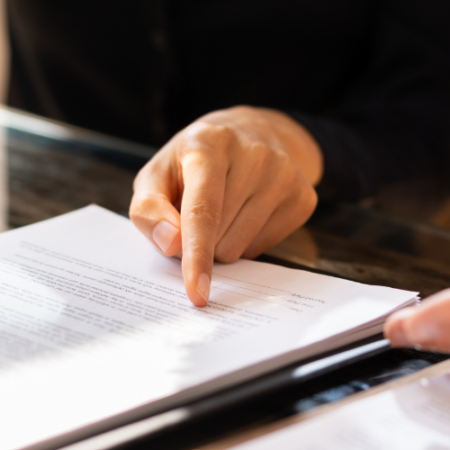
Disclosure regarding our editorial content standards.
Getting a sizable tax refund feels a bit like an extra paycheck—and unexpected income is always a fun surprise. It’s also pretty likely that you’ll see some sort of refund each year, as millions of Americans overpay on their taxes. Last year, for example, the Internal Revenue Service (IRS) reported that more than 125 million households received tax refunds, totaling more than $320 billion—or around $2,500 per person.
But what should you do with your tax refund? After all, a couple thousand dollars can make a dent in quite a few projects and purchases, so it can be helpful to decide where the money will have the most impact.
Below, we break down ideas for spending your tax refund into short-term financial goals, long-term financial goals and immediate gratification ideas.
Use the links to jump to a specific set of ideas, or read on for the full list.
1. Pay off high-interest debt
High-interest debt, like credit card debt or payday loan debt, will continue to generate interest charges until it is paid off. Generally, high-interest debt is considered to be anything with an interest rate above 10 percent.
The reason to prioritize paying off high-interest debt is that it will likely give you more money to spend down the road—even if it means less money immediately accessible to you. For example, if you use your tax refund to pay off a $2,000 credit card debt with 19 percent interest, you would save more than $400 in interest charges over the next two years.
Paying off high-interest debt is a bit like investing: The money you save in interest charges is the return on your investment—and it’s very rare to find any other investment with a higher percentage return than a credit card’s interest rate.
Key takeaway: If you have any high-interest debt, use your tax refund to make a lump-sum payment that will save you money in interest charges over time.
2. Create an emergency fund
An emergency fund can help cushion you against unexpected expenses. The Federal Reserve reports that around one-third of Americans would be unable to find funds to cover a $400 emergency expense—like a medical bill or car repair.
Financial experts recommend saving at least one month of expenses for emergencies, and if possible, it’s better to save three, six, or twelve months’ worth of expenses.

To find out how much you need to save, add up all of your necessary expenses (like housing, food, insurance) and multiply by the number of months you want your fund to cover. Putting your tax refund aside as the seed of an emergency fund can help you get started right away. Aim to keep your emergency fund in a savings account, as you’ll want that money to be available quickly if needed.
Key takeaway: An emergency fund helps protect you from unexpected expenses, so consider starting one right away with your tax refund.
3. Make a dent in your loans
Even if you have no high-interest debts, it’s still beneficial to take a look at your other debts to consider making extra payments. For example, auto or student loans with interest rates between 4 and 9 percent are still slowly draining money through interest charges.
A student loan of $25,000 at 7 percent interest will generate almost $5,000 of interest over five years. If you applied your tax refund of $3,000 directly to your loan balance, you’d save more than $500 in interest.
While loans with reasonable interest rates are not as financially dire as high-interest debt, they’re still worth paying off if you have the funds to do so. If you’re already covered with savings for financial emergencies, starting to knock out debt could be a sound financial approach.
Key takeaway: Debts like auto loans or student loans are good candidates for a tax refund, since the more you apply to your payment, the less you’ll pay in interest over time.
4. Make home improvements
If you own a home, using your tax refund to make upgrades is an investment with both short- and long-term benefits. The money you put into a home improvement project can immediately add to your quality of life, but it may also increase your home’s equity, providing a return on your investment if you sell the house later on.
With a modest tax refund, you could look at projects like installing gutters, repainting rooms, replacing some flooring or purchasing window treatments. Small projects can make a big difference in the livability of your home.
Key takeaway: If you’ve been putting off a necessary or a desired home upgrade, consider re-investing your tax refund in your home’s well-being.
5. Upgrade your home office
More and more Americans are working from home, and having a great setup can be the key to promoting productivity and peace. If your job has moved fully remote, it might be time to get your work-from-home environment upgraded.
Consider a better desk or an ergonomic chair for initial upgrades. You may also want to outfit your space with new lighting, decor or plants. Finally, tech upgrades like a dedicated Ethernet connection, an additional monitor or a new mouse and keyboard can make long days on the computer much more enjoyable.
Key takeaway: If your home office is currently the kitchen table, you may want to use your tax refund to build up a dedicated space for getting things done.
6. Retirement savings
If your immediate financial needs are covered, consider using your tax refund to start tackling long-term goals. For example, setting aside money for your retirement has very little immediate impact, but compounding interest means your investment today will mean a lot down the road.
If you put aside a tax refund of $2,500 in a retirement investment account at age 25, your money will grow to more than $17,000 at retirement with modest investment returns of 5 percent.

When opening a retirement account, consider either a 401(k) plan or an Individual Retirement Account (IRA). Many companies offer a 401(k) with matching, which means that your investments will be doubled by contributions from your company up to a certain amount. And your IRA has tax advantages—either by enabling pre-tax contributions or tax-free withdrawals at retirement, depending on the account you choose.
Key takeaway: Setting aside your tax refund for retirement doesn’t have an immediate effect, but compounding interest will give you a large return over time, providing you more money down the road.
7. College savings
Another long-term goal worth pursuing is setting up a 529 College Savings Plan for your children. These accounts enable you to generate interest on college savings, which can eventually be withdrawn tax free to pay for educational expenses.
Even a modest tax refund can grow significantly with 18 years to mature, helping to defray the rising tuition and housing costs associated with both public and private universities. After setting up the fund, consider making monthly contributions to help it grow enough to fully fund college for your children.
Key takeaway: A 529 College Savings Plan funded by your tax refund can help generate money to spend tax-free on education for your children down the road
8. Prepay mortgage
One of the largest debts most people acquire is a mortgage, which may stick around with you for 30 years or more. Fortunately, it is possible to prepay your mortgage with no penalty in most cases, and the effect of an extra payment can be twofold.
First, if you make extra payments, the total length of your mortgage is likely to decrease—so you’ll own your home outright sooner. Second, you’ll lessen the total cost of interest you’ll pay over the life of the loan, saving you money over time.
Key takeaway: If you’ve already squared away your other debts and investments, putting extra money toward your mortgage is a sound financial decision.
9. Purchase life insurance
Life insurance can help protect your loved ones in the case of your death, as they’ll receive a lump-sum payment to provide for them financially in your absence. While no one likes to consider death in their younger years, the cost of life insurance is often negligible compared to the financial security it provides.
For example, a $3,000 tax return can cover almost half of the cost of a 20-year life insurance policy for a healthy 40-year-old person. In the event of death, the family of the deceased would receive $500,000—far more than the $6,000 invested into the policy.
Key takeaway: Life insurance can be a wise investment to protect your family if you’ve already funded your tax-advantaged investment accounts.
10. Start a business
More Americans are self-employed than ever before—in fact, there are currently around 10 million American workers not answering to any boss but themselves according to the Bureau of Labor Statistics. If you’ve always wanted to start a business you’re passionate about, your tax refund could be the capital you need to get started.
With business tools becoming increasingly affordable, you may need little more than a website to get started working with customers and generating revenue. Your tax refund could provide the initial seed money to get your business off the ground, especially if you build your business while continuing to earn income from a full-time job.
Key takeaway: Starting a business involves a lot of work up front, but your tax refund could be the boost you need to cover initial expenses.
11. Buy something you want
If you’re already in good financial shape, there’s nothing wrong with using your tax refund for something nonessential. Assuming you’ve paid off high-interest debt, created an emergency fund and started investing for retirement, spending a bit on yourself is a reasonable reward for your financial discipline.

A financial windfall of several thousand dollars from your tax refund could be the permission you need to purchase a luxury item you’ve always wanted—like a high-tech exercise bike or a high-quality guitar. As long as you don’t let lifestyle creep influence your spending decisions going forward, a one-time splurge with your tax refund is usually just fine.
Key takeaway: If you’ve got all your financial ducks in a row, give yourself permission to buy something unnecessary that you wouldn’t normally purchase.
12. Take a vacation
Often, memorable experiences seem to provide more long-term joy than expensive items, so using your tax refund to take a bucket list trip could be the right decision for you. Again, you’ll want to make sure you have your necessities covered, but beyond that, a windfall is a great opportunity to travel somewhere you’ve always wanted to go.
By searching online for deals on flights or hotels, far-off destinations that you’ve always dreamed of could be within reach even with the average tax return of $2,500. While the long-term monetary returns would be higher if you invested that money, the memories and joy you’ll carry with you are worth the cost—especially if your tax refund was an unexpected and unneeded source of income.
Key takeaway: A dream vacation has the potential to continue providing joy for you with memories that will last a lifetime, so consider using your tax refund for travel.
13. Donate to charity
Sometimes, the best use of a financial windfall is to pay it forward. If your finances are in good shape, a charitable donation could be a great way to handle an unexpected source of income. Even if you only donate part of your tax refund, you can make a big difference, especially if you donate to a smaller or local charity.
Search online for charities that support causes you’re passionate about, and use part or all of your tax refund to make a charitable gift. Incidentally, charitable giving is tax deductible, so your generosity could also save you money on next year’s tax bill.
Key takeaway: If your financial needs are already taken care of, giving part or all of your tax refund to a vital charity is a great decision.
How your tax refund can boost your credit score
If your credit score isn’t where you want it to be, getting a large tax refund could be the support you needed. Your score is composed of several factors, and using your refund wisely could help you boost some of those factors to potentially increase your score.
For example, making payments on a loan could improve your payment history, and paying down credit card debt could lower your overall credit utilization.
If you need help figuring out where to get started, you may want to reach out to the team at CreditRepair.com, who can help you review your credit report and figure out a strategy for improving your credit—even potentially filing disputes against inaccurate information on your report.
Note: The information provided on CreditRepair.com does not, and is not intended to, act as legal, financial or credit advice; instead, it is for general informational purposes only.
Questions about credit repair?
Chat with an expert: 1-800-255-0263






